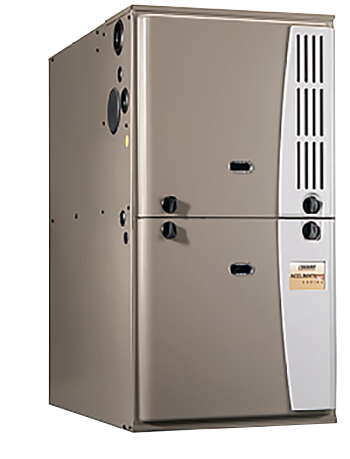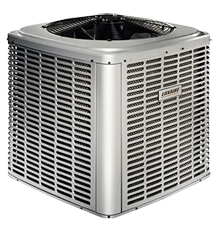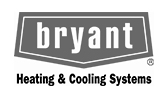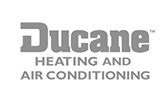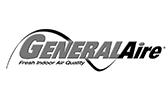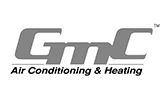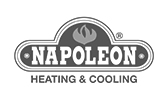HVAC Glossary
A
Absolute Humidity
The humidity of the air measured by the number of grains of water vapor present in one cubic meter of air.
Absolute Pressure
The sum of gauge and atmospheric pressure (psia).
Absolute Temperature
The temperature measured on the Kelvin scale.
Absolute Zero
The lowest temperature theoretically attainable on the Kelvin scale (approximately 273.16° C).
Absorbent
A substance with the ability to absorb another substance.
Absorption
In physics, the taking up of light, heat, or other energy by molecules. The absorbed energy is converted into heat. Absorption in chemistry is the taking up of one substance by another. For example, a gas such as oxygen may be absorbed, or dissolved, in water. In the HVAC industry heat energy is absorbed from the medium being cooled and transferred in the refrigerant.
Accumulator
A shell device installed in the suction line of a HVAC system to prevent liquids from entering the compressor.
Acrolein
An agent added to methyl chloride to make you aware of refrigerant leaks.
Activated Alumina
A type of aluminum oxide that absorbs moisture (used in refrigerant driers).
Activated Carbon
A processed carbon used in filter driers and commonly used in air filters to clean the air.
Active Cooling
HVAC term for compressor driven air conditioning.
Adiabatic
A change in gas condition where no heat is added or removed except in the form of work.
Adsorption
Adsorption, which is often confused with absorption, refers to the adhering of molecules of gases and liquids to the surfaces of porous solids. Adsorption is a surface phenomenon; absorption is an intermingling or interpenetration of two substances.
Air Balance
HVAC term for distributing air through a system to precisely match the required amount.
Air Cleaning
In HVAC an IAQ control strategy to remove various airborne particulates and/or gases from the air. The three types of air cleaning most commonly used are particulate filtration, electrostatic precipitation, and gas sorption.
Air Conditioner
A device used to control temperature and humidity of the air.
Air Conditioning
In HVAC the control of the quality, quantity, and temperature-humidity of the air in an interior space.
Air Diffuser
HVAC term for an air distribution outlet, typically located in the ceiling, which mixes conditioned air with room air.
Air Exchange Rate
In HVAC the rate at which outside air replaces indoor air in a space. Expressed in one of two ways: the number of changes of outside air per unit of time – air changes per hour (ACH); or the rate at which a volume of outside air enters per unit of time – cubic feet per minute (CFM).
Air Handler
HVAC term for a fan-blower, heat transfer coil, and housing parts of a system.
Air Handling Unit (AHU)
In HVAC refers to equipment that includes a blower or fan, heating and/or cooling coils, and related equipment such as controls, condensate drain pans, and air filters. Does not include ductwork, registers or grilles, or boilers and chillers.
Air Infiltration
The unwanted entrance of air due to leakage, temperature difference, or wind.
Air Passages
Openings through or within walls, through floors and ceilings, and around chimney flues and plumbing chases, that permit air to move out of the conditioned spaces of the building.
Air Retarder/Barrier
A material or structural element that inhibits air flow into and out of a building’s envelope or shell. This is a continuous sheet composed of polyethylene, polypropylene, or extruded polystyrene. The sheet is wrapped around the outside of a house during construction to reduce air in-and exfiltration, yet allow water to easily diffuse through it.
Air Standard
HVAC term for air having a temperature of 68 degrees F (20 degrees C) and a relative humidity of 36%% at 14.7 psia.
Air to Air
Where both the condensing and evaporating mediums are air.
Air Vent
HVAC term for a valve, either manual or automatic, that is used to remove unwanted air from the highest point of a piping system.
Alcohol Brine
Water and alcohol solution witch remains a liquid below 32 degress F.
Allergen
A substance capable of causing an allergic reaction because of an individual’s sensitivity to that substance.
Ambient Air
The air external to a building or device.
Attic
The usually unfinished space above a ceiling and below a roof.
Attic Fan
A fan mounted on an attic wall used to exhaust warm attic air to the outside.
Attic Vent
HVAC term for a passive or mechanical device used to ventilate an attic space, primarily to reduce heat buildup and moisture condensation.
Available Heat
The amount of heat energy that may be converted into useful energy from a fuel.
B
Blower
In HVAC the device in an air conditioner that distributes the filtered air from the return duct over the coil/heat exchanger. This circulated air is cooled/heated and then sent through the supply duct, past dampers, and through supply diffusers to the living/working space.
Boiler
A vessel or tank where heat produced from the combustion of fuels such as natural gas, fuel oil, or coal is used to generate hot water or steam for applications ranging from building space heating to electric power production or industrial process heat.
Boiler Pressure
The pressure of the steam or water in a boiler as measured, usually expressed in pounds per square inch gauge (psig).
Boiler Rating
The heating capacity of a steam boiler expressed in BTU per hour (BTU/H), horsepower, or pounds of steam per hour.
Bottled Gas
A generic term for liquefied and pressurized gas, ordinarily butane, propane, or a mixture of the two, contained in a cylinder for domestic use.
Breathing Zone
Area of a room in which occupants breathe as they stand, sit, or lie down.
British Thermal Unit (BTU)
The amount of heat required to raise the temperature of one pound of water one degree Fahrenheit, equal to 252 calories.
Building Envelope
Elements of the building, including all external building materials, windows, and walls, that enclose the internal space.
Burner Capacity
The maximum heat output (in BTU per hour) released by a burner with a stable flame and satisfactory combustion.
C
Carbon Dioxide (CO2)
A colorless, odorless noncombustible gas with the formula CO2 that is present in the atmosphere. It is formed by the combustion of carbon and carbon compounds (such as fossil fuels and biomass), by respiration, which is a slow combustion in animals and plants, and by the gradual oxidation of organic matter in the soil.
Carbon Monoxide (CO)
A colorless, odorless but poisonous combustible gas with the formula CO. Carbon monoxide is produced in the incomplete combustion of carbon and carbon compounds such as fossil fuels (i.e. coal, petroleum) and their products (e.g. liquefied petroleum gas, gasoline), and biomass.
Ceiling Plenum
Space below the flooring and above the suspended ceiling that accommodates the mechanical and electrical equipment and that is used as part of the air distribution system. The space is kept under negative pressure.
Central Air Conditioning
See Air Conditioner.
Central Air Handling Unit (Central AHU)
This is the same as an Air Handling Unit, but serves more than one area.
Central Heating System
In HVAC a system where heat is supplied to areas of a building from a single appliance through a network of ducts or pipes.
CFM Cubic feet per minute
HVAC term for the amount of air, in cubic feet, that flows through a given space in one minute. 1 CFM equals approximately 2 liters per second (l/s).
Chimney
A masonry or metal stack that creates a draft to bring air to a fire and to carry the gaseous byproducts of combustion safely away.
Chimney Effect
The tendency of heated air or gas to rise in a duct or other vertical passage, such as in a chimney, small enclosure, or building, due to its lower density compared to the surrounding air or gas.
Combination Foundations
Buildings constructed with more than one foundation type; e.g., basement/crawlspace or basement/slab-on-grade.
Combustion
The process of burning; the oxidation of a material by applying heat, which unites oxygen with a material or fuel.
Combustion Air
Air that provides the necessary oxygen for complete, clean combustion and maximum heating value.
Combustion Chamber
Any wholly or partially enclosed space in which combustion takes place.
Combustion Gases
The gaseous byproducts of the combustion of a fuel.
Compressor
A device used to compress air for mechanical or electrical power production, and in air conditioners, heat pumps, and refrigerators to pressurize the refrigerant and enabling it to flow through the system.
Condenser
The device in an air conditioner or heat pump in which the refrigerant condenses from a gas to a liquid when it is depressurized or cooled.
Condenser Coil
The device in an air conditioner or heat pump through which the refrigerant is circulated and releases heat to the surroundings when a fan blows outside air over the coils. This will return the hot vapor that entered the coil into a hot liquid upon exiting the coil.
Condensing Unit
The component of a central air conditioner that is designed to remove heat absorbed by the refrigerant and transfer it outside the conditioned space.
Conditioned Air
Air that has been heated, cooled, humidified, or dehumidified to maintain an interior space within the “comfort zone.” (Sometimes referred to as “tempered” air.)
Conditioned Space
The interior space of a building that is heated or cooled.
Constant Air Volume Systems
Air handling system that provides a constant air flow while varying the temperature to meet heating and cooling needs.
Cooling Capacity
The quantity of heat that a cooling appliance is capable of removing from a room in one hour.
Cooling Degree Day
A value used to estimate interior air cooling requirements (load) calculated as the number of degrees per day (over a specified period) that the daily average temperature is above 65 degrees Fahrenheit (or some other, specified base temperature). The daily average temperature is the mean of the maximum and minimum temperatures recorded for a specific location for a 24 hour period.
D
Dampers
HVAC term for controls that vary airflow through an air outlet, inlet, or duct. A damper position may be immovable, manually adjustable or part of an automated control system.
Degree Day
A unit for measuring the extent that the outdoor daily average temperature (the mean of the maximum and minimum daily dry-bulb temperatures) falls below (in the case of heating, see Heating Degree Day), or falls above (in the case of cooling, see Cooling Degree Day) an assumed base temperature, normally taken as 65 degrees Fahrenheit, unless otherwise stated. One degree day is counted for each degree below (for heating) or above (in the case of cooling) the base, for each calendar day on which the temperature goes below or above the base.
Degree Hour
The product of 1 hour, and usually the number of degrees Fahrenheit the hourly mean temperature is above a base point (usually 65 degrees Fahrenheit); used in roughly estimating or measuring the cooling load in cases where processes heat, heat from building occupants, and humidity are relatively unimportant compared to the dry-bulb temperature.
Dehumidifier
A device for reducing the level of humidity in a room or home.
Demand (tankless) Water Heater
A type of water heater that has no storage tank thus eliminating storage tank stand-by losses. Cold water travels through a pipe into the unit, and either a gas burner or an electric element heats the water only when needed.
Diffusers and Grilles
Components of the ventilation system that distribute and return air to promote air circulation in the occupied space. As used in this document, supply air enters a space through a diffuser or vent and return air leaves a space through a grille.
Direct Water Heater
A type of water heater in which heated water is stored within the tank. Hot water is released from the top of the tank when a hot water faucet is turned. This water is replaced with cold water that flows into the tank and down to just above the bottom plate under which are the burners.
Draft
A column of burning combustion gases that are so hot and strong that the heat is lost up the chimney before it can be transferred to the house. A draft brings air to the fire to help keep it burning.
Draft Diverter
A door-like device located at the mouth of a fireplace chimney flue for controlling the direction and flow of the draft in the fireplace as well as the amount of oxygen that the fire receives.
Draft Hood
A device built into or installed above a combustion appliance to assure the escape of combustion byproducts, to prevent backdrafting of the appliance, or to neutralize the effects of the stack action of the chimney or vent on the operation of the appliance.
Dual Duct System
An air conditioning system that has two ducts, one is heated and the other is cooled, so that air of the correct temperature is provided by mixing varying amounts of air from each duct.
Duct Fan
HVAC term for an axial flow fan mounted in a section of duct to move conditioned air.
Duct(s)
The round or rectangular tube(s), generally constructed of sheet metal, fiberglass board, or a flexible plastic-and-wire composite, located within a wall, floor, and ceiling that distributes heated or cooled air in buildings.
E
Environmental Agents
Conditions other than indoor air contaminants that cause stress, comfort, and/or health problems (e.g., humidity extremes, drafts, lack of air circulation, noise, and over-crowding).
Environmental Tobacco Smoke (ETS)
Mixture of smoke from the burning end of a cigarette, pipe, or cigar and smoke exhaled by the smoker (also secondhand smoke (SHS) or passive smoking).
Ergonomics
Applied science that investigates the impact of people’s physical environment on their health and comfort (e.g., determining the proper chair height for computer operators).
Exhaust Ventilation
HVAC term for mechanical removal of air from a portion of a building (e.g., piece of equipment, room, or general area).
F
Filter (air)
A device that removes contaminants, by mechanical filtration, from the fresh air stream before the air enters the living space. Filters can be installed as part of a heating/cooling system through which air flows for the purpose of removing particulates before or after the air enters the mechanical components.
Fireplace Insert
A wood or gas burning heating appliance that fits into the opening or protrudes on to the hearth of a conventional fireplace.
Flue
The structure (in a residential heating appliance, industrial furnace, or power plant) into which combustion gases flow and are contained until they are emitted to the atmosphere.
Flue Gas
The gas resulting from the combustion of a fuel that is emitted to the flue.
Forced Air System or Furnace
HVAC term for a type of heating system in which heated air is blown by a fan through air channels or ducts to rooms.
Freon
A registered trademark for a cholorfluorocarbon (CFC) gas that is highly stable and that has been historically used as a refrigerant.
Fuel Efficiency
The ratio of heat produced by a fuel for doing work to the available heat in the fuel.
Fuel Oil
Any liquid petroleum product burned for the generation of heat in a furnace or firebox, or for the generation of power in an engine. Domestic (residential) heating fuels are classed as Nos. 1, 2, 3; Industrial fuels as Nos. 4, 5, and 6.
Fungi
Any of a group of parasitic lower plants that lack chlorophyll, including molds and mildews.
Furnace (Residential)
In HVAC a combustion heating appliance in which heat is captured from the burning of a fuel for distribution, comprised mainly of a combustion chamber and heat exchanger.
G
Gas Sorption
HVAC term for devices used to reduce levels of airborne gaseous compounds by passing the air through materials that extract the gases. The performance of solid sorbents is dependent on the airflow rate, concentration of the pollutants, presence of other gases or vapors, and other factors.
H
Heat
A form of thermal energy resulting from combustion, chemical reaction, friction, or movement of electricity. As a thermodynamic condition, heat, at a constant pressure, is equal to internal or intrinsic energy plus pressure times volume.
Heat Loss
The heat that flows from the building interior, through the building envelope to the outside environment.
Heat Rate
The ratio of fuel energy input as heat per unit of net work output; a measure of a power plant thermal efficiency, generally expressed as Btu per net kilowatt-hour.
Heat Register
The grilled opening into a room by which the amount of warm air from a furnace can be directed or controlled; may include a damper.
Heating Capacity (Also Specific Heat)
The quantity of heat necessary to raise the temperature of a specific mass of a substance by one degree.
Heating Degree Day(s) (HDD)
The number of degrees per day that the daily average temperature (the mean of the maximum and minimum recorded temperatures) is below a base temperature, usually 65 degrees Fahrenheit, unless otherwise specified; used to determine indoor space heating requirements and heating system sizing. Total HDD is the cumulative total for the year/heating season. The higher the HDD for a location, the colder the daily average temperature(s).
Heating Load
The rate of heat flow required to maintain a specific indoor temperature; usually measured in Btu per hour.
HEPA
High efficiency particulate arrestance (filters).
Home Energy Rating Ssystems (HERS)
A nationally recognized energy rating program that gives builders, mortgage lenders, secondary lending markets, homeowners, sellers, and buyers a precise evaluation of energy losing deficiencies in homes. Builders can use this system to gauge the energy quality in their home and also to have a star rating on their home to compare to other similarly built homes.
Hot Air Furnace
A heating unit where heat is distributed by means of convection or fans.
Humidifier
A device for increasing the humidity in a room or home.
Humidity
A measure of the moisture content of air; may be expressed as absolute, mixing ratio, saturation deficit, relative, or specific.
HVAC
HVAC is an acronym for heating, ventilation, and air-conditioning system.
K
Kerosene
A type of heating fuel derived by refining crude oil that has a boiling range at atmospheric pressure from 400 degrees to 550 degrees F.
M
Mechanically Ventilated Crawlspace System
In HVAC a system designed to increase ventilation within a crawlspace, achieve higher air pressure in the crawlspace relative to air pressure in the soil beneath the crawlspace, or achieve lower air pressure in the crawlspace relative to air pressure in the living spaces, by use of a fan.
Mitigation
Measure taken to reduce adverse effects on the environment.
N
Natural Ventilation
In HVAC the movement of outdoor air into a space through intentionally provided openings, such as windows and doors, or through nonpowered ventilatiors or by infiltration.
Negative Pressure
Condition that exists when less air is supplied to a space than is exhausted from the space, so the air pressure within that space is less than that in surrounding areas. Under this condition, if an opening exists, air will flow from surrounding areas into the negatively pressurized space.
O
Organic Compounds
Chemicals that contain carbon. Volatile organic compounds vaporize at room temperature and pressure. They are found in many indoor sources, including many common household products and building materials.
Outdoor Air
Air taken from the external atmosphere and, therefore, not previously circulated through the system.
Outdoor Air Supply
HVAC term for air brought into a building from the outdoors (often through the ventilation system) that has not been previously circulated through the system. Also known as “Make-Up Air”.
P
Particulate Matter
A state of matter in which solid or liquid substances exist in the form of aggregated molecules or particles. Airborne particulate matter is typically in the size range of 0.01 to 100 micrometers.
Particulates
Fine liquid or solid particles such as dust, smoke, mist, fumes, and fog found in air and emissions.
Plenum
HVAC term for an air compartment connected to a duct or ducts.
Positive Pressure
Condition that exists when more air is supplied to a space than is exhausted, so the air pressure within that space is greater than that in surrounding areas. Under this condition, if an opening exists, air will flow from the positively pressurized space into surrounding areas.
Pressure, Static
In flowing air, the total pressure minus velocity pressure. The portion of the pressure that pushes equally in all directions.
PRESSURE, TOTAL
In flowing air, the sum of the static pressure and the velocity pressure.
Pressure, Velocity
In flowing air, the pressure due to the velocity and density of the air.
Preventative Maintenance
Regular and systematic inspection, cleaning, and replacement of worn parts, materials, and systems. Preventive maintenance helps to prevent parts, material, and systems failure by ensuring that parts, materials and systems are in good working order.
ProgrammableThermostat
A type of thermostat that allows the user to program into the devices’ memory a pre-set schedule of times (when certain temperatures occur) to turn on HVAC equipment.
Propane
A hydrocarbon gas, C3H8, occurring in crude oil, natural gas, and refinery cracking gas. It is used as a fuel, a solvent, and a refrigerant. Propane liquefies under pressure and is the major component of liquefied petroleum gas (LPG).
R
R-Value
A measure of the capacity of a material to resist heat transfer. The R-Value is the reciprocal of the conductivity of a material (U-Value). The larger the R-Value of a material, the greater its insulating properties.
Radiant Barrier
In HVAC a thin, reflective foil sheet that exhibits low radiant energy transmission and under certain conditions can block radiant heat transfer; installed in attics to reduce heat flow through a roof assembly into the living space.
Radiant Ceiling Panels
Ceiling panels that contain electric resistance heating elements embedded within them to provide radiant heat to a room.
Radiant Energy
Energy that transmits away from its source in all directions.
Radiant Floor
A type of radiant heating system where the building floor contains channels or tubes through which hot fluids such as air or water are circulated. The whole floor is evenly heated. Thus, the room heats from the bottom up. Radiant floor heating eliminates the draft and dust problems associated with forced air heating systems.
Radiant Heat Transfer
Radiant heat transfer occurs when there is a large difference between the temperatures of two surfaces that are exposed to each other, but are not touching.
Radiant Heating System
HVAC term for a heating system where heat is supplied (radiated) into a room by means of heated surfaces, such as electric resistance elements, hot water (hydronic) radiators, etc.
Radiator
A room heat delivery (or exchanger) component of a hydronic (hot water or steam) heating system; hot water or steam is delivered to it by natural convection or by a pump from a boiler.
Radiator Vent
A device that releases pressure within a radiator when the pressure inside exceeds the operating limits of the vent.
Re-entry
Situation that occurs when the air being exhausted from a building is immediately brought back into the system through the air intake and other openings in the building envelope.
Recirculated Air
Air removed from the conditioned space and used for ventilation, heating, cooling, humidification, or dehumidification.
Refrigerant
The compound (working fluid) used in air conditioners, heat pumps, and refrigerators to transfer heat into or out of an interior space. This fluid boils at a very low temperature enabling it to evaporate and absorb heat.
Refrigeration
The process of the absorption of heat from one location and its transfer to another for rejection or recuperation.
Refrigeration Capacity
A measure of the effective cooling capacity of a refrigerator, expressed in Btu per hour or in tons, where one (1) ton of capacity is equal to the heat required to melt 2,000 pounds of ice in 24 hours or 12,000 Btu per hour.
Relative Humidity
A measure of the percent of moisture actually in the air compared with what would be in it if it were fully saturated at that temperature. When the air is fully saturated, its relative humidity is 100 percent.
Return Air
Air that is returned to a heating or cooling appliance from a heated or cooled space.
Return Duct
The central heating or cooling system contains a fan that gets its air supply through these ducts, which ideally should be installed in every room of the house. The air from a room will move towards the lower pressure of the return duct.
S
Seasonal Energy Efficiency Ratio (SEER)
A measure of seasonal or annual efficiency of a central air conditioner or air conditioning heat pump. It takes into account the variations in temperature that can occur within a season and is the average number of Btu of cooling delivered for every watt-hour of electricity used by the heat pump over a cooling season.
Setback Thermostat
A thermostat that can be set to automatically lower temperatures in an unoccupied house and raise them again before the occupant returns.
Soffit
A panel which covers the underside of an roof overhang, cantilever, or mansard.
Space Heater
A movable or fixed heater used to heat individual rooms.
Specific Humidity
The weight of water vapor, per unit weight of dry air.
Split System Air Conditioner
HVAC term for an air conditioning system that comes in two to five pieces: one piece contains the compressor, condenser, and a fan; the others have an evaporator and a fan. The condenser, installed outside the house, connects to several evaporators, one in each room to be cooled, mounted inside the house. Each evaporator is individually controlled, allowing different rooms or zones to be cooled to varying degrees.
Stack
A smokestack or flue for exhausting the products of combustion from a combustion appliance.
Stack (Heat) Loss
Sensible and latent heat contained in combustion gases and vapor emitted to the atmosphere.
Stack Effect
The overall upward movement of air inside a building that results from heated air rising and escaping through openings in the building super structure, thus causing an indoor pressure level lower than that in the soil gas beneath or surrounding the building foundation.
Stand-by Heat Losses
A term used to describe heat energy lost from a water heater tank.
Static Pressure
Condition that exists when an equal amount of air is supplied to and exhausted from a space. At static pressure, equilibrium has been reached.
Steam
Water in vapor form; used as the working fluid in steam turbines and heating systems.
Steam Boiler
A type of furnace in which fuel is burned and the heat is used to produce steam.
Storage Water Heater
A water heater that releases hot water from the top of the tank when a hot water tap is opened. To replace that hot water, cold water enters the bottom of the tank to ensure a full tank.
Supply Duct
HVAC term for the duct(s) of a forced air heating/cooling system through which heated or cooled air is supplied to rooms by the action of the fan of the central heating or cooling unit.
T
Tankless Water Heater
A water heater that heats water before it is directly distributed for end use as required; a demand water heater.
Temperature Zones
In HVAC individual rooms or zones in a building where temperature is controlled separately from other rooms or zones.
Therm
A unit of heat containing 100,000 British thermal units(BTU).
Ton (Air Conditioning)
A unit of air cooling capacity; 12,000 Btu per hour.
U
Unit Ventilator
HVAC term for a fan-coil unit package device for applications in which the use of outdoor- and return-air mixing is intended to satisfy tempering requirements and ventilation needs.
V
Vapor Retarder
A material that retards the movement of water vapor through a building element (walls, ceilings) and prevents insulation and structural wood from becoming damp and metals from corroding. Often applied to insulation batts or separately in the form of treated papers, plastic sheets, and metallic foils.
Variable Air Volume System (VAV)
Air handling system that conditions the air to constant temperature and varies the outside airflow to ensure thermal comfort.
Vent
A component of a heating or ventilation appliance used to conduct fresh air into, or waste air or combustion gases out of, an appliance or interior space.
Vent Damper
HVAC term for a device mounted in the vent connector that closes the vent when the heating unit is not firing. This traps heat inside the heating system and house rather than letting it draft up and out the vent system.
Vent Pipe
A tube in which combustion gases from a combustion appliance are vented out of the appliance to the outdoors.
Vented Heater
A type of combustion heating appliance in which the combustion gases are vented to the outside, either with a fan (forced) or by natural convection.
Ventilation
The process of moving air (changing) into and out of an interior space either by natural or mechanically induced (forced) means.
Ventilation Air
Defined as the total air, which is a combination of the air brought inside from outdoors and the air that is being re-circulated within the building. Sometimes, however, used in reference only to the air brought into the system from the outdoors; this document defines this air as “outdoor air ventilation.”
Ventilation Rate
The rate at which indoor air enters and leaves a building. Expressed in one of two ways: the number of changes of outdoor air per unit of time (air changes per hour, or “ach”) or the rate at which a volume of outdoor air enters per unit of time (cubic feet per minute, or “cfm”).
W
Weatherization
In HVAC caulking and weatherstripping to reduce air infiltration and exfiltration into/out of a building.
Weatherstripping
A material used to seal gaps around windows and exterior doors.
Z
Zone
In HVAC an area within the interior space of a building, such as an individual room(s), to be cooled, heated, or ventilated. A zone has its own thermostat to control the flow of conditioned air into the space.
Zoning
The combining of rooms in a structure according to similar heating and cooling patterns. Zoning requires using more than one thermostat to control heating, cooling, and ventilation equipment.
Easy Rentals...
Service Area
DeMark Home Ontario servicing area for HVAC-furnaces, air conditioners, heat pumps, hot water heaters, tankless units includes: Toronto, GTA, Vaughan, Mississauga, Brampton, Markham, Scarborough, Milton, Burlington, Niagara Falls, Oshawa, Pickering, Ajax, Aurora, Newmarket, Barrie and more. For a full servicing area please click here.

